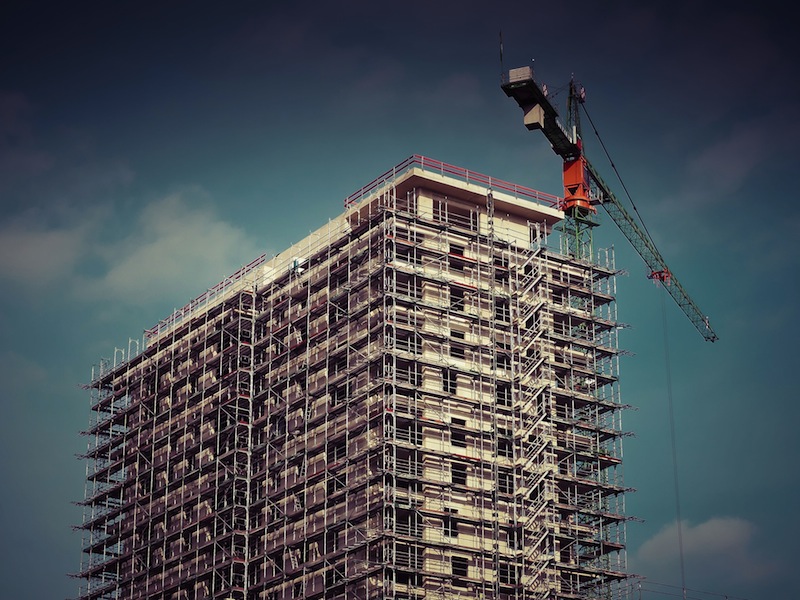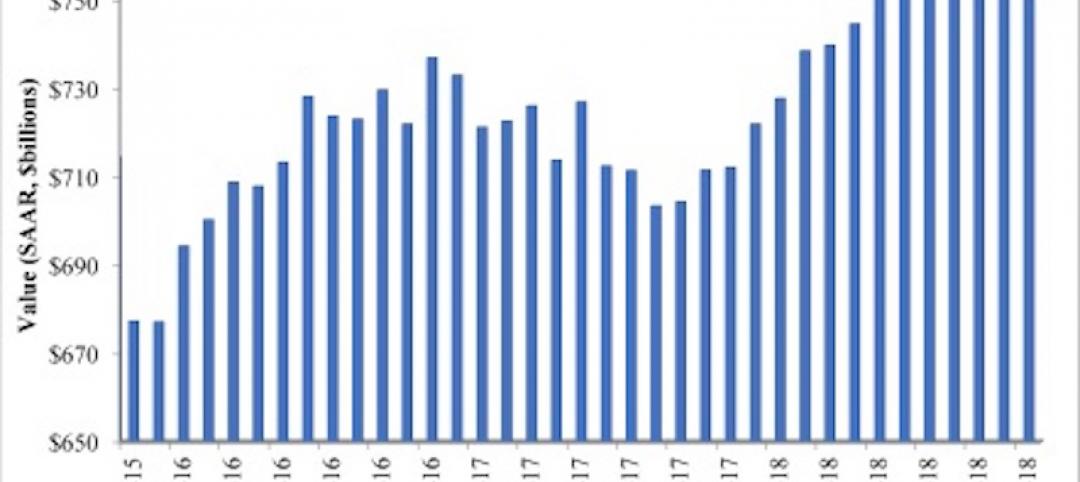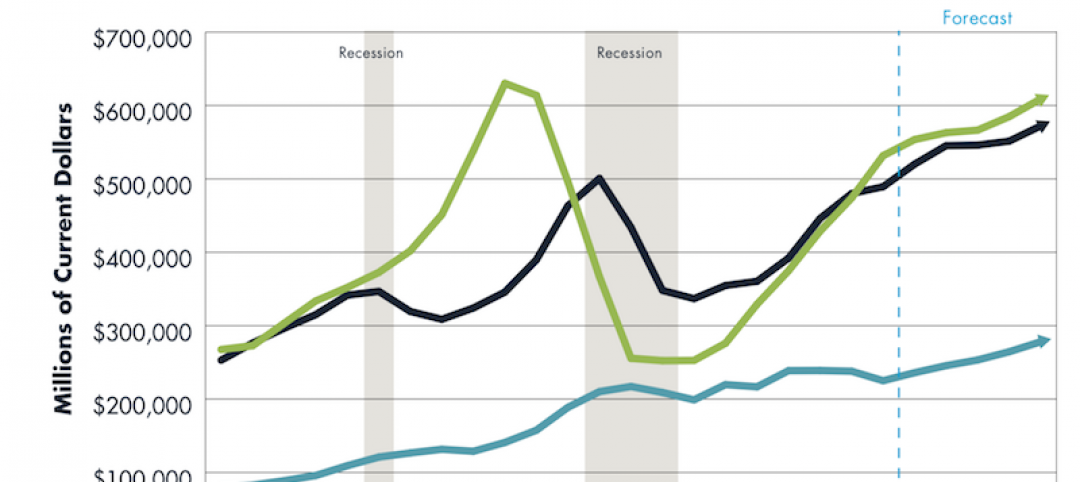Nonresidential construction activity should remain strong in the U.S. through 2016, although labor shortages and the rising cost of sheet glass will make projects more expensive, according to JLL’s latest Construction Outlook.
JLL sees the South as the country’s “new frontier” for construction, thanks to the region’s low labor and land costs. Conversely, the erosion in oil prices is cramping building in places like Houston whose economics rely heavily on their energy industries.
Sustainable office development pushed renovation activity to new heights in 2015. “This push for new build-outs was not limited to office spaces, with retail and industrial developers redeveloping existing space to include new technology and engage consumers in unique ways,” JLL’s 34-page report states, adding that this trend should continue this year.
The report sees positive signs in construction employment, which outpaced the country’s 4% growth rate. JLL also surveyed development firms that, in the main, agree that construction activity should be steady at least through the second half of 2016, and possibly well beyond that.
Building materials costs, which had increased incrementally since 2010, appear to have plateaued last year. The steel market was flooded by low-cost product, for example. The one notable exception was sheet glass, whose prices have skyrocketed, leading, some construction companies to acquire glass makers to stabilize their costs.
While materials costs are always a concern, JLL notes that labor costs—wages and benefits—have spiked, particularly for skilled workers. Average weekly wages for construction workers rose in December 2015 by 4.2% compared to the same month a year earlier. Massachusetts, New York, and Washington D.C. have the highest weekly construction wages; Georgia, Missouri, and Colorado the lowest.
Industrial sector a ‘shining star’
JLL estimates the value of construction put in place rose 10.2% last year through November, with the Education (up 12% in construction activity) and Manufacturing sectors driving the train. But all of the top construction markets also saw at least a 1% increase in construction costs from the second to the fourth quarter of last year.
“For financial viability, project sponsors will need to strike a balance between the lower costs for some materials, like steel, and the ever-increasing cost of glass and labor,” says Todd Burns, President, Project and Development Services, JLL Americas. “Location continues to be a key driver in finding success throughout various industry sectors. With a slowed growth in construction, executives need to think strategically in terms of where they will invest.”
The researcher sees parallels between construction costs and rents. It points specifically to the San Francisco Bay Area, where construction and office leasing are among the highest in the country.
Nationwide, office deliveries outpaced starts for the first time since the recession, in terms of total square footage, and approached pre-recession numbers. Office completions in every quarter last year were higher than corresponding quarters in 2014. And with the exception of Houston, where office construction was off nearly 42% last year, office construction activity was steady in most top markets.
As of the fourth quarter of last year, there were 88.5 million sf of office space under construction, nearly 9% more than in fourth-quarter 2014. The quarter-to-quarter gains in industrial construction were even more pronounced during this period: 23%. (JLL refers to the industrial sector as nonresidential construction’s “shining star,” and estimates that 178.4 million sf of industrial space were delivered last year.)
Dallas (with 19.7 million sf of industrial space under construction as of the fourth quarter) and Atlanta (19.6 million sf) eclipsed California’s Inland Empire as this sector’s leading markets.
JLL’s take on Retail construction is that while it was off slightly last year, it still showed fourth-quarter gains in all major markets. (Ironically, Houston was the leader, with 2.9 million sf under construction in the fourth quarter, followed by New York City, with 2.7 million.) Retail vacancies across the country declined as the economy improved.
“We have never seen a greater sense of urgency from retailers to address their stores’ role in delivering a ‘True Omni Branded Experience’ for consumers,” says Aaron Spiess, Executive Vice President, Managing Director, Project and Development Services, JLL Americas. “The pressure of emerging digital experiences and platforms has escalated the need to exceed consumer expectations of the store. With the continuous advent of new e-commerce capabilities, this is a trend we expect to continue.”
The 2016 general election looms large in JLL’s forecast. “The upcoming fight over the debt ceiling could delay government buildings and other public works,” its report states. JLL also notes that a slowing global economy could have a silver lining by causing material prices to fall further.
But don’t expect wage costs to taper off any time soon, it predicts. “There remains a dearth of trained construction employees, especially in trade positions, and wages are rising as a result.”
In its final analysis, JLL foresees construction starts will increase at a slower rate than last year, but ahead of the overall economy. “Demand from downstream markets such as Austin, Chicago, Atlanta, and Charlotte will bolster the industry, and construction profit margins will continue to rise, keeping construction growing at a faster rate than the overall economy.”
Related Stories
Market Data | Feb 28, 2019
U.S. economic growth softens in final quarter of 2018
Year-over-year GDP growth was 3.1%, while average growth for 2018 was 2.9%.
Market Data | Feb 20, 2019
Strong start to 2019 for architecture billings
“The government shutdown affected architecture firms, but doesn’t appear to have created a slowdown in the profession,” said AIA Chief Economist Kermit Baker, Hon. AIA, PhD, in the latest ABI report.
Market Data | Feb 19, 2019
ABC Construction Backlog Indicator steady in Q4 2018
CBI reached a record high of 9.9 months in the second quarter of 2018 and averaged about 9.1 months throughout all four quarters of last year.
Market Data | Feb 14, 2019
U.S. Green Building Council announces top 10 countries and regions for LEED green building
The list ranks countries and regions in terms of cumulative LEED-certified gross square meters as of December 31, 2018.
Market Data | Feb 13, 2019
Increasingly tech-enabled construction industry powers forward despite volatility
Construction industry momentum to carry through first half of 2019.
Market Data | Feb 4, 2019
U.S. Green Building Council announces annual Top 10 States for LEED Green Building in 2018
Illinois takes the top spot as USGBC defines the next generation of green building with LEED v4.1.
Market Data | Feb 4, 2019
Nonresidential construction spending dips in November
Total nonresidential spending stood at $751.5 billion on a seasonally adjusted annualized rate.
Market Data | Feb 1, 2019
The year-end U.S. hotel construction pipeline continues steady growth trend
Project counts in the early planning stage continue to rise reaching an all-time high of 1,723 projects/199,326 rooms.
Market Data | Feb 1, 2019
Construction spending is projected to increase by more than 11% through 2022
FMI’s annual outlook also expects the industry’s frantic M&A activity to be leavened by caution going forward.
Market Data | Jan 23, 2019
Architecture billings slow, but close 2018 with growing demand
AIA’s Architecture Billings Index (ABI) score for December was 50.4 compared to 54.7 in November.

















